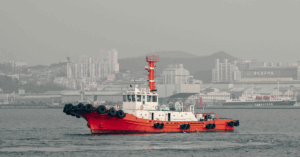China Commissions First Hydrogen-Electric Tugboat At Qingdao Port
China has officially put its first hydrogen-electric tugboat into service. The vessel, named Hydrogen-Electric Tug No.1, or “Qing Dian Tuo 1,” began operations on June 26 at Qingdao Port in eastern China’s Shandong Province.
The tugboat uses a hybrid propulsion system that combines hydrogen fuel cells with liquid-cooled lithium batteries. This setup enables the vessel to run with zero carbon emissions and operate for more than 12 hours at a speed of 9 knots.
It also delivers a strong towing force of 82 tons, making it the most powerful harbor tug in the country and one with the largest lithium battery capacity to date.
According to local port officials, this innovation is expected to reduce over 1,500 tons of carbon dioxide emissions annually compared to conventional diesel-powered tugboats. It also offers improvements in noise control, equipment lifespan, and energy efficiency.
The tugboat was designed and built by the “Liangang Innovation Team” at Shandong Port Qingdao Port Group Co., Ltd. It includes advanced technologies such as the Beidou satellite navigation system and a fully automated intelligent shore-based charging setup.
Zhang Lei, deputy general manager of Qingdao Port’s barge company, was quoted as saying that the vessel’s deployment is a significant move toward reducing emissions during port operations and advancing the port’s shift toward intelligent and green infrastructure.
This initiative is part of Qingdao Port’s hydrogen energy strategy. In the first half of 2025, the port also began joint commissioning and testing of 10 hydrogen-powered rail cranes and 300kW cogeneration hydrogen fuel cells. These efforts aim to promote the use of hydrogen energy across all port scenarios.
In addition to equipment upgrades, Qingdao Port has also developed a green energy coordination system and successfully completed northern China’s first international ship biofuel oil refueling operation.
Port authorities plan to continue expanding hydrogen use and further modernise port equipment.
References: fuelcellsworks, chinanews

